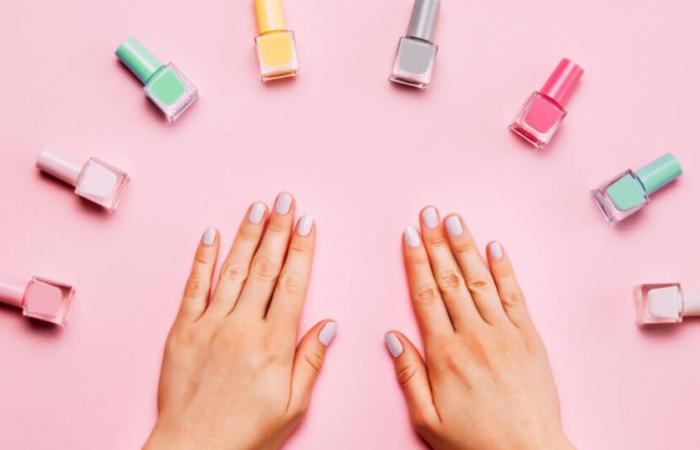The movement clean beauty is taking the beauty world by storm, and it’s no longer limited to skincare and makeup. Now, even our manicure routines are taking a more health- and eco-friendly approach. No more varnishes saturated with chemicals and make way for gentle alternatives.
Danger to health and the planet
For decades, nail polishes and removers have contained powerful chemicals necessary to ensure long wear, beautiful shine and vibrant color. However, some of these ingredients have been found to have harmful effects on nails. According to several recent studies, repeated use of varnishes containing these products can make them more fragile and brittle. But that’s not all: certain substances cause allergies, irritations and even hormonal disruptions. Without forgetting that manicure professionals are the people most exposed, inhaling these products daily.
These, beyond the effects on health, also pose environmental problems. Chemical solvents and plasticizers found in varnishes and gels have a negative impact on the planet. The manufacturing process and the release of these products into nature contribute to soil and water pollution.
Another often overlooked aspect of traditional manicures is the use of UV lamps to cure semi-permanent polishes and gels. Although these devices provide a durable and shiny finish, they emit ultraviolet type A (UVA) rays which can pose health risks. A study published in 2023 in the journal Nature has also revealed that regular exposure to these lamps could damage the DNA of skin cells, thus increasing the risk of skin cancer.
A long transition
But then, if polishes and other manicure accessories are so harmful, why has the transition to gentler alternatives taken so long? Because replacing these toxic components with safer ones has been a real challenge. Ingredients like formaldehyde, toluene or phthalates play a crucial role in traditional formulas, and eliminating them required years of research to maintain a similar finish and effectiveness.
Many brands now offer “3-free”, “7-free” or even “10-free” formulas (which exclude up to ten controversial molecules from their composition), guaranteeing varnishes more or less free of toxic products. Natural ingredients, such as vegetable oils and botanical extracts, replace harsh solvents and resins.
Vigilance, again and again!
Although the clean manicure trend promises healthier and more natural formulas, it is important to remain vigilant. As the French-speaking Consumer Federation (FRC) explains in an article in 2023: “100% natural varnish does not exist! Indeed, whatever product you choose, it will contain nitrocellulose, a polymer made chemically from cellulose. No varnish can, at present, do without chemical substances.” The words “natural” or “clean” can then lead to confusion, suggesting a composition completely exempt from chemistry, which is rarely the case.
The association also specifies that even “free” formulas that do not contain certain harmful ingredients are not automatically synonymous with complete safety. In reality, substitutes used in place of toxic substances may themselves present a risk, hence the need for increased vigilance.
It is therefore essential to favor products with clear and transparent ingredients, to read labels carefully and to obtain information using applications such as INCI Beauty, Yuka, or FRC Cosmétiques, for example. Finally, you can also adopt simple habits, such as avoiding UV lamps and spacing out varnish applications, in order to take care of your nails while respecting your health and the environment.
5 questions to Joan Wann, beautician and founder of the Peau Lys institute in Lausanne
FEMINA Why did you choose to move towards more natural nail products?
John Wan I have always been attracted to organic and natural products in general. For me, taking care of yourself goes beyond the simple aesthetic dimension. It is also about using products that are beneficial to health and respectful of the environment.
What are the main differences you see between classic manicure products and more natural alternatives?
Having worked with conventional products for a long time, I have found that natural formulas are less damaging to nails. These are less weakened, less brittle. In addition, the application and removal methods of natural products are much less aggressive for the nail.
Do “clean” varnishes offer the same hold and shine as classic varnishes?
Of course, each solution has its advantages and limitations. Indeed, the hold and shine of natural varnishes can sometimes be inferior to those of classic semi-permanent varnishes. However, it all depends on the person. I have clients whose manicures last up to ten days, which proves that results can vary.
What advice would you give for adopting a more natural and eco-friendly manicure routine?
It is important to distinguish natural from eco-responsible. Opting for natural products while throwing away all the old products isn’t really eco-friendly, is it?
I therefore advise starting by using a natural base, then continuing with your classic varnish, so as not to waste. From there, you can gradually progress to a completely “clean” manicure over time.
What do you think is the future of “clean manicure”? Will we still see other innovations emerge?
It is unlikely that natural gel or acrylic versions will ever be available. On the other hand, I think that more and more brands will offer cleaner ranges in the future. Research continues to advance in this area, and I am convinced that we will succeed in developing formulas that are more pigmented, shinier and longer lasting.
Semi-Permanent Nail Polish Kit 24W Green Flash, Manucurist, Happy Officine, 96 fr. © DR
Dream of honey hands and nails, Nuxe, approx. 11 fr. the 50 ml. © DR
Lakur Nail Polish, Spilled Wine, Londontown, 21 fr. 90 for 12 ml. © DR
Nail Polish, Be My Baby, Benecos, 3 fr. 90 for 5 ml. © DR
Nail polish remover, Mavala, 5 fr. 40 for 50 ml. © DR
Organic Rose Infusion Oil, Kure Bazaar, 49 fr. 90 for 10 ml. © DR
Castor oil, Melvita, 17 fr. 90 for 50 ml. © DR
Did you like this content? Subscribe to our newsletter to receive all our new articles!






